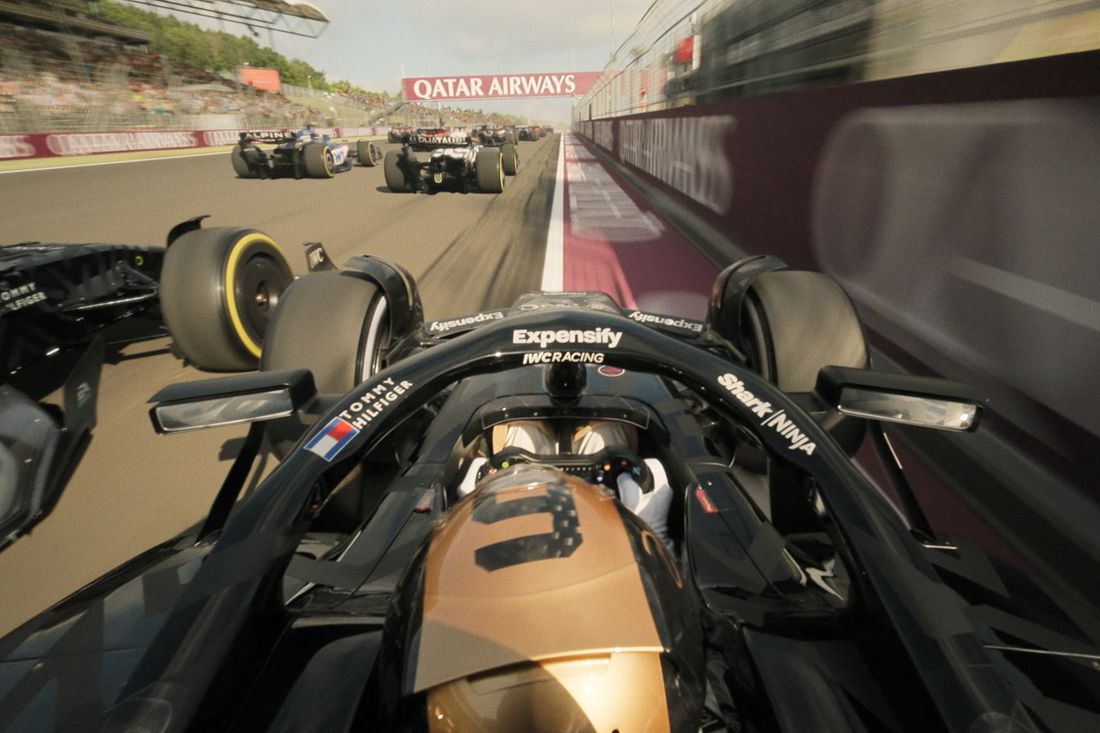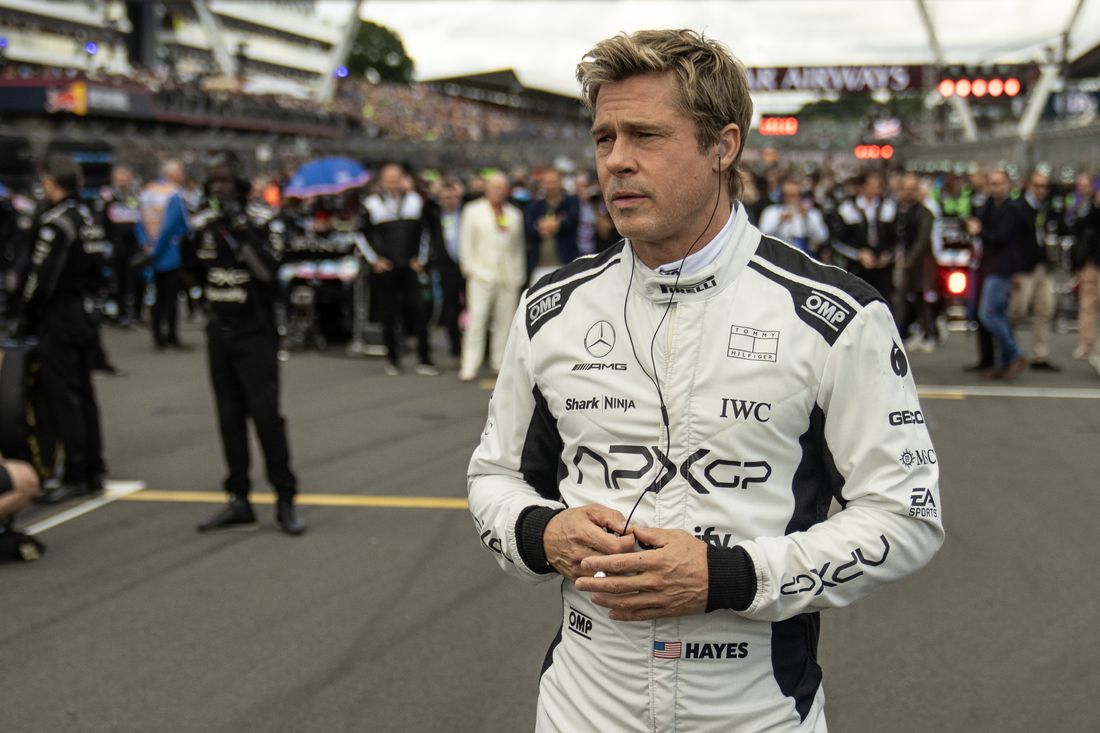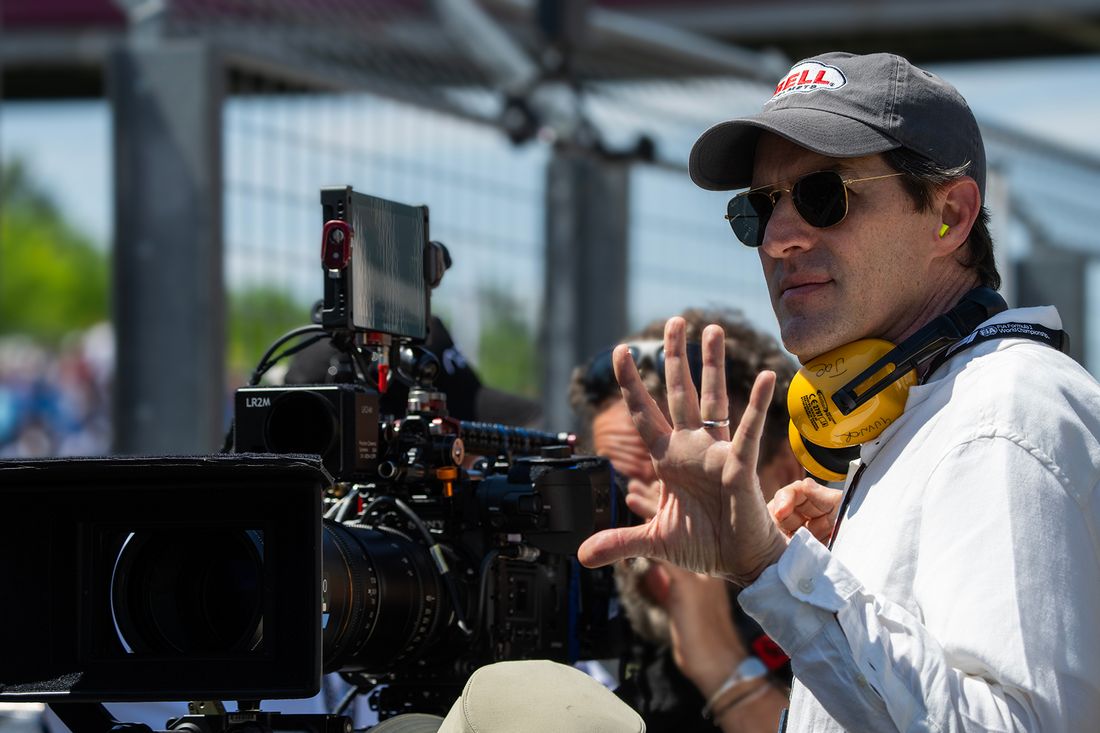
As shared by director Joseph Kosinski, one of the key influences for the movie “F1: The Movie” was a day he spent observing a team of Mercedes engineers construct a racing car at breathtaking speed in front of his very eyes. Before creating this film, the director believed that nothing could surpass the excitement of standing on an aircraft carrier surrounded by two F-18 jets taking off simultaneously. However, his perception changed when he entered the Mercedes garage during the Grand Prix in Austin and watched these engineers assemble a car from factory-fresh components in real time. He saw Lewis Hamilton climb into it, becoming one with the vehicle. The car then dropped to the ground, drove out, and set a new lap record.
The breathtaking scenes of Formula One racing were what ultimately persuaded Kosinski to delve into this realm. His fascination with the interplay between humans and technology has been long-standing, and it’s evident from the onset of the film through the portrayal of newcomer driver Joshua Pearce (Damson Idris). Upon our first encounter, Joshua seems almost indistinguishable from the high-tech vehicle he operates. He’s not just a person; he’s also a digital readout, a series of numbers in a constant struggle against other numerical data. This is underscored by his training sessions, where sensors monitor his vital signs, and during races, where data points on screens show his performance at various track sections.
Into the world steps Sonny Hayes, portrayed by Brad Pitt, a seasoned yet rough-edged racer who was forced out of Formula One many years ago due to a crash. Unlike Joshua, who trains with sophisticated gym equipment to fortify his neck muscles, Sonny prefers outdoor workouts, such as jogging on the track. Sonny is a man of superstitions, prone to mood swings and unpredictability. He doesn’t conform to machines; instead, he pushes them to their limits – sometimes beyond their breaking point – to suit his will. When racing, it’s not just about speed for Sonny; he performs risky moves that verge on disqualification yet provide an advantage.

This narrative pattern is commonly found in summer blockbusters, such as in “Top Gun: Maverick” and “Rocky IV”. In “Top Gun: Maverick”, the Tom Cruise character emphasized that only human pilots could accomplish the mission at hand due to their ability to adapt and exceed limits others couldn’t. Similarly, Rocky Balboa trained amidst harsh conditions while Ivan Drago utilized advanced equipment in a high-tech gym. This trope is often present in stories about underdogs, like those that attract Kosinski. He also found inspiration for “F1” from the first season of “Formula One: Drive to Survive”, which focused on struggling racing teams. Unlike adversaries, Joshua and Sonny are teammates who each drive their own car, making them both allies and competitors who must learn cooperation.
In the hands of a different director, this kind of conflict might be limited to conversations or serve as a mere plot device. However, since his first feature film directing venture, “Tron: Legacy” (2010), Kosinski has proven himself as a filmmaker exceptional at portraying the emotional nuances of life in our technology-dominated era. Unlike the original “Tron” from 1982, which was set within a video game and featured glowing figures against a black background to mimic an arcade screen, Kosinski’s sequel unfolds under eternal night with dark mountains silhouetted against deep-black skies filled with ominous clouds. While it appears to be the same game, the empty spaces now carry existential weight: Paired with a narrative about digital avatars aiming to supplant their human creators, the film exudes a poignant sense of nothingness.
Oblivion, the title of Kosinski’s second movie, features Tom Cruise as a guard patrolling a barren Earth that has become lethal to all life forms. Over time, he discovers his clone status, being part of an army created by an invisible artificial alien intelligence with the purpose of eradicating humanity. The planet is not deserted because people have left, but because they’ve been destroyed. The ominous skies from Tron: Legacy transform into the bleak and desolate landscapes of Oblivion. In the visually captivating climax, Cruise’s character embarks on a self-destructive journey to an orbiting space station and penetrates the alien force’s lair – a vast, eerie chamber, more chilling for its vast emptiness. The alien intelligence is symbolized by a massive floating pyramid, enigmatic and unknowable; it appears that these aliens are characterized by their void-like nature.
Joseph Kosinski, who originally studied architecture before transitioning into filmmaking, possesses a unique knack for portraying how environment shapes character and emotion, which significantly contributed to the impactful nature of “Top Gun: Maverick”. Beyond its thrilling fighter-jet narrative, it serves as a poignant contemplation on Tom Cruise’s iconic persona and America’s evolving global role. The film carries a haunting atmosphere; Cruise’s character frequently gives off a spectral presence, leading some to speculate that the story could be a premonition of his demise. Few blockbusters with a billion-dollar budget have ever felt as somber and isolating. Despite not meeting his apparent fate in the movie, Maverick seems on the brink of disappearance. A recurring theme is the impending obsolescence of pilots due to drone technology. Kosinski’s films, including his heart-wrenching 2017 firefighting drama “Only the Brave” and his futuristic 2022 Netflix thriller “Spiderhead”, all exhibit a bittersweet longing for the post-human era. His characters struggle against a universe that could continue without them, yet they are also irresistibly drawn to it. He masterfully conveys both the dread and the awe-inspiring beauty of a world no longer reliant on human existence.

Kosinski, in his perspective, acknowledges that everyone grapples with technology, finding it a persistent challenge. However, he emphasizes our significance within the world we inhabit. This concept, he believes, resonates with many. As a filmmaker, Kosinski leverages technology to enhance his work. During the production of Maverick, he and his cinematographer, Claudio Miranda, drew inspiration from real Navy pilots who mounted GoPros on their canopies for training exercises. To capture actors in real fighter planes, they developed a fixed camera system. For F1, Kosinski pondered whether it was feasible to film a Formula One race while one was actually underway. This required innovating smaller and more adaptable cameras, providing the director unprecedented insight into the vehicle and the actors’ actions. According to Kosinski, this project involved a year of research and development as the necessary camera system didn’t yet exist. Collaborating with Sony, they miniaturized, lightened, and streamlined the Top Gun: Maverick system to suit their needs.
In the filming of Maverick, Kosinski prepared the actors on a plywood replica of an aircraft before sending them into actual jets to essentially guide themselves. For the movie F1, he aimed for greater control and flexibility. “I wanted to be able to maneuver the camera and control it in real time,” he explains. “Since we were shooting in IMAX, the depth of field is shallow, so I desired the ability to adjust focus – to transition from a car chasing him to Brad’s eyes.” The technology they created allowed the director to view the footage live, pan the camera, and modify focal length in a vehicle traveling at nearly 200 miles per hour.
During their global tour, filming Formula One races at various renowned circuits for about two years, the team ensured constant communication by positioning their command center right in the middle of the racetrack, never straying further than half a mile from the cars as they maneuvered. “I managed 16 different camera angles,” Kosinski explained, “and I could operate four positions concurrently. This meant we had two cars with four cameras each operating simultaneously. I received eight live feeds and controlled the panning of all cameras. It was like working on a live TV broadcast: ‘Move to position three, adjust focus, two.’ The job on race day was quite different.
In contrast to the other environments Kosinski has portrayed, the scenes and spaces within F1 are unique. Unlike being described as empty or desolate, these settings teem with life. The director fills the screen with spectators, racers, and pit crews, all working together in a captivating display of teamwork. As Formula One fascinated him, he expressed that “one person in one machine on this weekend” is the result of a thousand individuals’ efforts. In F1, people aren’t just cogs in the machinery; they become the machinery themselves, operating harmoniously to save mere fractions of seconds during pit stops and races. Remarkably, this synergy even extends to the audience. Through various camera angles and positions, Kosinski manages to create an all-encompassing experience for viewers, making us feel as if we are a part of the vehicle ourselves.
However, even though F1 continues to evoke an enigmatic longing for forgetfulness, which appears to be a recurring theme in Kosinski’s characters, Sonny, who was brought up as a racer from his youth, grapples with the loss of his passion for racing following a devastating accident in the past. He yearns to rediscover it. “There are rare instances,” Sonny admits, “when there’s a moment in the car where everything becomes silent.” This moment represents a blend of solitude and liberation. “I can see everything, yet no one — no one — can reach me,” he says. This feeling resonates with our world, where escape is achievable only through the very things that necessitate it. If Maverick occasionally felt like a spirit seeking human form again, Sonny seems to be a human striving to regain his spectral existence. What sets Kosinski’s work apart is his ability to find the ethereal beauty in that perpetually changing dance.
Read More
- 50 Ankle Break & Score Sound ID Codes for Basketball Zero
- Who Is Harley Wallace? The Heartbreaking Truth Behind Bring Her Back’s Dedication
- 50 Goal Sound ID Codes for Blue Lock Rivals
- Mirren Star Legends Tier List [Global Release] (May 2025)
- League of Legends MSI 2025: Full schedule, qualified teams & more
- 28 Years Later Fans Go Wild Over Giant Zombie Dongs But The Director’s Comments Will Shock Them
- Pacers vs. Thunder Game 7 Results According to NBA 2K25
- Basketball Zero Boombox & Music ID Codes – Roblox
- Pacers vs. Thunder Game 1 Results According to NBA 2K25
- Nintendo Switch 2 System Update Out Now, Here Are The Patch Notes
2025-06-27 21:54